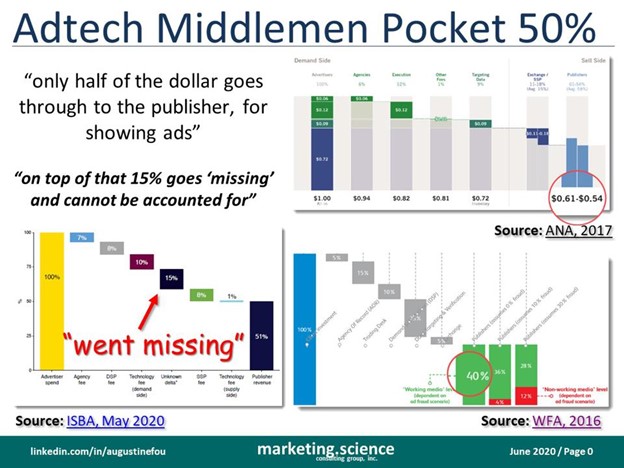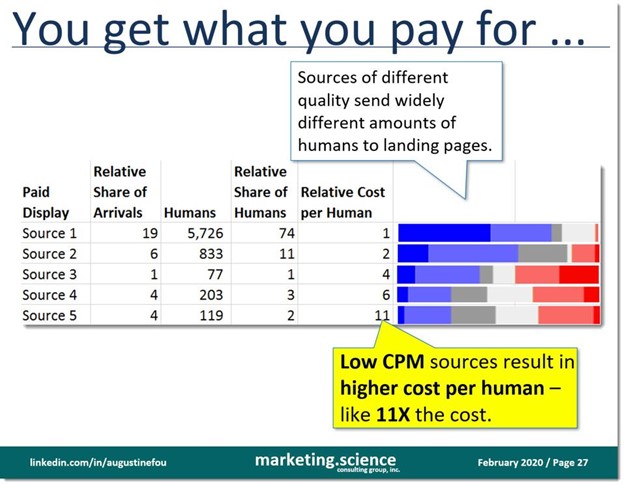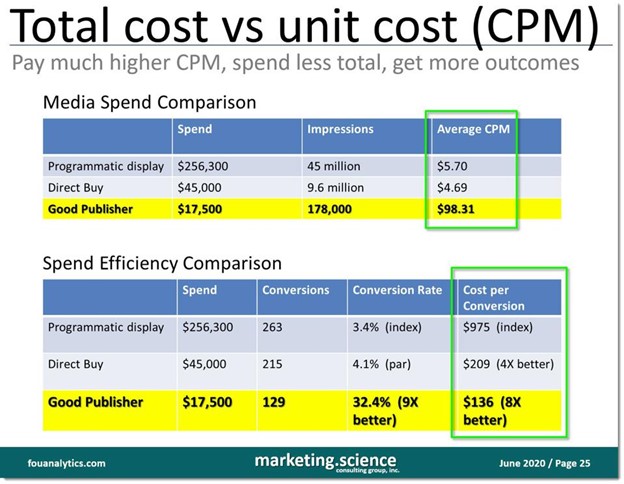Unit Cost vs Total Cost
Most marketers look lovingly and longingly at the sweet, sweet low prices they are getting now with programmatic ad exchanges selling ads to them at $3 CPMs (cost per thousand impressions). They think back to the days they had to pay $30 CPMs to major publishers for showing ads on those sites. And in their own minds, they are heroes — we’re getting much better prices than ever before, we saved so much money.
But sadly, that’s no more than a mental hiccup. Marketers buying digital ads at $3 today are buying ten times the quantity. So $3 x 10 still makes $30. They are still spending $30, and didn’t actually save any money. The difference is, by buying ads at $3 from exchanges, no matter how much fraud detection you have in place, you’re buying lower quality impressions. Because there are millions of sites chomping at your ad budgets, some of those are outright fraudulent and fake sites, with no content at all and all bot traffic.
So marketers have convinced themselves they were saving money because the unit costs (CPMs) were lower; but they didn’t realize that the total costs may be the same or higher because they are buying larger quantities of ads than ever before.
50% Ad Tech Tax
The other hidden cost of buying through programmatic channels is the ad tech “tax” of 50% or more. This means that for every dollar spent buying media through programmatic channels, 50 cents goes into the adtech middlemens’ pockets instead of towards showing ads. Three industry-wide studies from 2015 onward have corroborated this — that on average only 50 cents of a dollar goes to the publisher to show the ad. In what other industry would you be OK paying 50% tax on anything?
So to get the same amount of ad impressions, you’d actually have to buy double the quantity, just to be “par” with buying ads directly from publishers, so that all your money goes towards showing ads. Of course you can’t realistically do this direct-buying with hundreds of thousands of sites. But that is the point. You don’t need to. Where do humans go? They go to sites that they know about or have heard about. Do you go to a bunch of sites you have never heard of, over and over and over again? No.
So buying ads from good, mainstream publishers that you and other humans have heard about means you don’t have to spray your ads to millions of sites. You can use programmatic platforms to do this by buying or targeting the specific dealIDs that specific publishers have set up in specific exchanges. This minimizes the length and complexity of the programmatic supply chain and this eliminates most of the adtech tax you didn’t know you were paying for.

Ad Fraud and “Missing Money”
Notice something else in the chart above? Right, “went missing.” When the accounting firm that ran the study tried to connect the dollar as it traveled from the buyer (advertiser) to the seller (publisher), they could not account for 15% on average, with a range of 2% to 86%. That’s right, in one campaign they analyzed 86% of the money went missing — i.e. could not be accounted for. In what other industry or situation would you be OK with missing nearly 9 out of 10 oranges you just paid for?
And when buying through programmatic channels, have you accounted for all the ad fraud eating up your budgets? Of course you have reports that tell you fraud is low. But what if those detection vendors were only looking for IVT (invalid traffic — i.e. bots) and missing all the other forms of fraud that they were not looking for? Or what if the bots were smart enough to trick the detection or to simply block their detection tag so they could avoid the detection. Yeah, it’s that simple. If your ad was shown to a bot, even ones that were not detected, it cannot have any impact on your business outcomes. You are trying to do marketing right? So you end up having to buy more and more ad impressions, hoping that will have drive more results. Sound familiar? Yeah, you’re paying more because of ad fraud and money gone missing, you just don’t realize it yet.
Extra Costs of Fraud, Viewability, Brand Safety Detection
Most marketers who buy cheap ads in programmatic channels know about ad fraud, viewability issues, and brand safety issues. So they pay extra for fraud detection, viewability detection, and brand safety detection technologies. Often those are bundled together in the dollars paid to the media agency, unless the marketer contracts directly for those services. Not only are there issues with undisclosed kickbacks (e.g. fraud detection vendor gives cash “rebates” and “incentives” to media agencies) and those technologies not working as well as they promised, there’s the simple fact that you are paying CPM+ (additional fees on top of media CPMs) for such detection technologies. These extra costs may offset any savings you might think you got buy buying cheaper ads through programmatic channels. You could also avoid incurring these extra costs, if you bought media directly from good publishers that have real human audiences in the first place. Of course those media CPMs are higher, but “you get what you pay for” (while you can avoid unnecessary extra costs.)

Higher Cost per Human, Lower hCPM (humanCPM)
In addition to avoiding bots and fraud, you should have analytics in place to tell you if your ads are being shown to humans. In the chart above, Source 1 is a source of display ads that has the highest CPM, while Source 5 is a display ad source that has the lowest CPM. So most marketers are buying large quantities of ad impressions from the likes of Source 5, simply because CPMs are lowest. However, if you focus in on the amount of humans (dark blue), there is a huge difference between Source 1 and Source 5. Source 1 has a lot more humans, while Source 5 has the least.
If you care about showing ads to humans, then paying higher CPMs to Source 1 means far more of your ads are shown to humans. Even if you paid lower CPM prices to Source 5, it ends up costing you a lot more because there were so few humans there. In fact, in this specific example, the cost per showing ads to humans or hCPM (humanCPM) is 11X higher than Source 1. You literally get what you pay for, and you didn’t get much “ads shown to humans” when buying from Source 1. You’re paying more, you just didn’t know it.
Cost per Conversion
Finally, you’re looking to drive real conversions right? Even if you’re not a DTC (direct-to-consumer) brand or ecommerce site, you still want real business outcomes, right? Of course. That’s the marketer’s job. That’s your job — to drive sales and conversions — not just spend all the budget by the end of the quarter. When marketers actually take the trouble to track conversions, they can easily tell that paying higher CPMs, buying fewer ads, and showing ads to humans all combine to drive better “spend efficiency.”
In this case, “efficiency” does not mean “low prices” as it does with most media agencies buying digital ads for clients. “Spend efficiency” means the lowest cost per actual conversion. In this example the cost per conversion was 1/8 that of buying cheap ads in programmatic channels. Even if you chose to ignore the ad tech tax, fraud, and missing money issues of programmatic channels, this should be the hard evidence you need to see for yourself. The lowest actual cost for achieving business outcomes comes from careful, thoughtful media planning and buying.

There is little merit to “spray and pray” and large quantities. There is little merit in getting low unit prices (CPMs) when your total costs are no lower. There is no merit in paying extra for fraud detection, viewability, and brand safety services when the ads are not being shown on sites that humans visit, or shown to humans anyway. So what most marketers are doing now costs them more; they just don’t know it yet. Smart marketers have already taken matters into their own hands and are buying more direct, paying higher CPMs, buying fewer impressions, and showing more ads to humans (using analytics to monitor it themselves). This is how you actually save costs and become the marketing superhero.